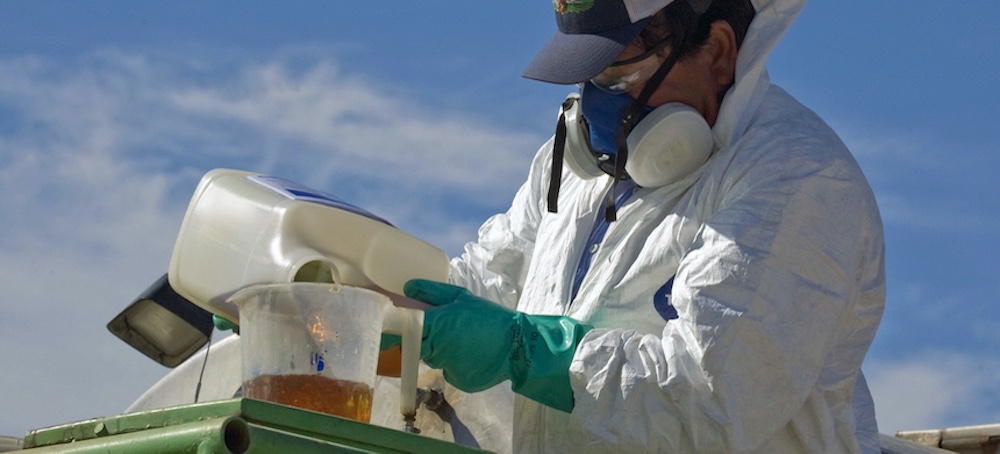US Court Bans Three Weedkillers and Finds EPA Broke Law in Approval Process
Johnathan Hettinger Guardian UK A worker mixes herbicides, which will be sprayed on a field. (photo: David Bacon/Report Digital-REA/Redux)
A worker mixes herbicides, which will be sprayed on a field. (photo: David Bacon/Report Digital-REA/Redux) US Court Bans Three Weedkillers and Finds EPA Broke Law in Approval Process
Johnathan Hettinger Guardian UK
Ruling, specific to three dicamba-based weedkillers, is major blow to Bayer, BASF and Syngenta
The ruling is specific to three dicamba-based weedkillers manufactured by Bayer, BASF and Syngenta, which have been blamed for millions of acres of crop damage and harm to endangered species and natural areas across the midwest and south.
This is the second time a federal court has banned these weedkillers since they were introduced for the 2017 growing season. In 2020, the ninth circuit court of appeals issued its own ban, but months later the Trump administration reapproved the weedkilling products, just one week before the presidential election at a press conference in the swing state of Georgia.
But a federal judge in Arizona ruled on Monday that the EPA made a crucial error in reapproving dicamba, finding the agency did not post it for public notice and comment as required by law. US district judge David Bury wrote in a 47-page ruling that it was a “very serious” violation and that if EPA had done a full analysis, it probably would not have made the same decision.
Bury wrote that the EPA did not allow many people who are deeply affected by the weedkiller – including specialty farmers, conservation groups and more – to comment.
The lawsuit was filed by farmer and conservation groups.
“Time and time again, the evidence has shown that dicamba cannot be used without causing massive and unprecedented harm to farms as well as endangering plants and pollinators,” said George Kimbrell, legal director of the Center for Food Safety, which litigated the case.
An EPA spokesman, Jeffrey Landis, said the agency was still reviewing the ruling but declined to comment further.
Dicamba was introduced to American agriculture in 1967, but was never widely used during warm months because it was well known that the chemical can volatilize and move long distances when temperatures climb. Volatilization is when dicamba particles turn from a liquid to a gas in the hours or days after the herbicide is applied, in effect turning into clouds of weedkiller and causing landscape-level damage.
Dicamba is also prone to drifting on the wind far from where it is applied. And it can move into drainage ditches and bodies of water as runoff during rain events.
Monsanto, along with the chemical giant BASF, introduced new formulations of dicamba herbicides they said would not be as volatile, and they encouraged farmers to buy Monsanto’s newly created dicamba-tolerant crops. Farmers buying the specialized seeds could spray dicamba on fields while the crops were growing, killing the weeds, but not the precious commodities.
Dicamba-resistant crops have been planted on as many as 65m acres, the EPA estimated, an area larger than the state of Oregon.
The EPA first approved Monsanto and BASF versions of dicamba touted to be less likely to move off target for the 2017 growing season. Since then, dicamba has caused millions of acres of crop damage, and has been the subject of several lawsuits.
In February 2020, a federal jury in Missouri awarded the state’s largest peach farmer $265m for damage to his farm, though that total was later reduced by a federal judge. In June 2020, Bayer announced a $400m settlement with soybean growers that had been damaged by non-target drift.
For years, Bayer and BASF have blamed other factors than their weedkillers, including illegal use of older chemicals, for the damage. Discovery documents turned up in the litigation showed the companies knew that their dicamba weedkillers would probably lead to off-target crop damage.
Other documents filed in the lawsuit show that the EPA was in a rush to approve dicamba in October 2020, with scientists complaining that they did not have enough time to do a proper analysis, the New Lede found.
One year later, the EPA issued a report that found dicamba was still spreading from where it was applied to adjacent areas, and it was doubtful that dicamba, used on tens of millions acres of cotton and soya bean crops in the US, could legally be kept on the market.
Bury wrote that if the EPA properly considered the risks, comments from state agriculture agencies, specialty farmers and others, it probably would not reapprove dicamba.
The ruling affects Bayer’s dicamba-based XtendiMax herbicide, which it inherited when it acquired Monsanto in 2018, as well as Syngenta’s Tavium weedkiller and BASF’s Engenia weedkiller.
In a statement issued after the ruling, Bayer said it disagreed with the court ruling and was “assessing” how to respond. “Our top priority is making sure growers have the approved products and support they need to safely and successfully grow their crops.”
BASF also said in a statement that it was assessing its legal options and awaiting direction from the EPA in light of the order. Syngenta did not provide an immediate response to a request for comment.
The news comes at a particularly bad time for Bayer, which is reeling from other Monsanto-related weedkilling product problems, notably mass litigation over Monsanto’s glyphosate-based Roundup herbicides, which has so far cost Bayer billions in jury verdicts and settlements and eroded shareholder confidence. Plaintiffs allege Roundup causes non-Hodgkin’s lymphoma.
Syngenta is also facing nationwide litigation over its paraquat herbicide, which thousands of plaintiffs claim causes Parkinson’s disease.
